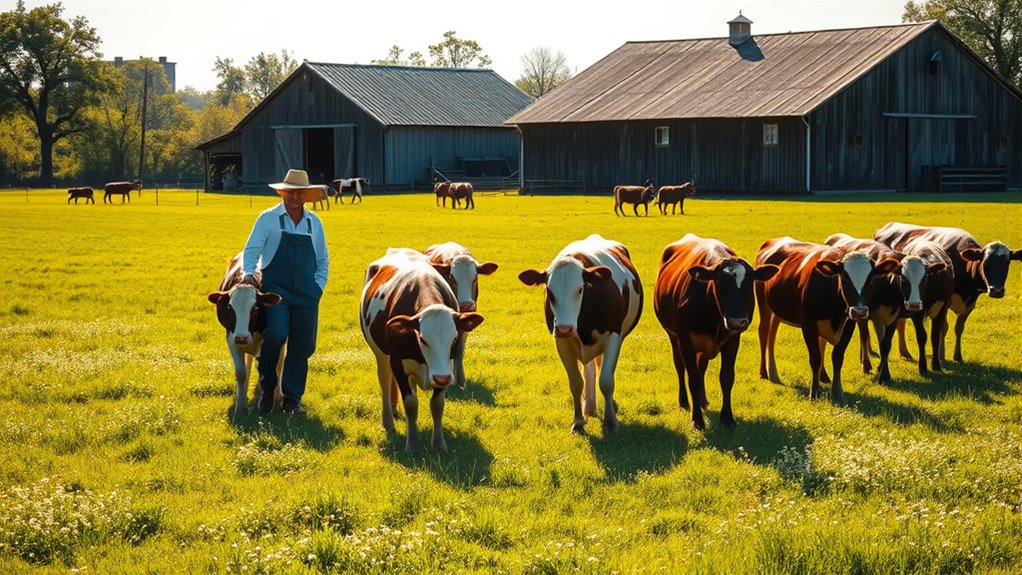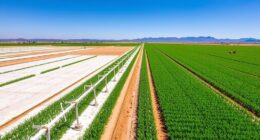To manage a small dairy herd, focus on cow nutrition by providing the right balance of energy, vitamins, and forage. Establish good breeding practices by tracking heat cycles and guaranteeing heifers calve under 24 months. Maintain a clean, calm milking environment while prioritizing hygiene to guarantee milk quality. Provide comfortable living conditions, including clean bedding and proper ventilation. Don't forget about regular veterinarian care to maintain herd health. You'll discover even more essential tips next!
Key Takeaways
- Ensure proper nutrition based on the cow's stage of life, adjusting feeding strategies for non-pregnant, pregnant, and lactating cows.
- Maintain detailed records of breeding cycles and health checks to enhance reproductive performance and overall herd productivity.
- Create a calm milking environment, prioritize hygiene, and monitor milk quality to ensure high yields and prevent contamination.
- Provide clean bedding, proper ventilation, and ample space to promote cow comfort and reduce stress-related issues.
- Schedule regular veterinary care and preventative measures to maintain cow health and safeguard the herd's overall well-being.
Key Principles of Dairy Herd Management
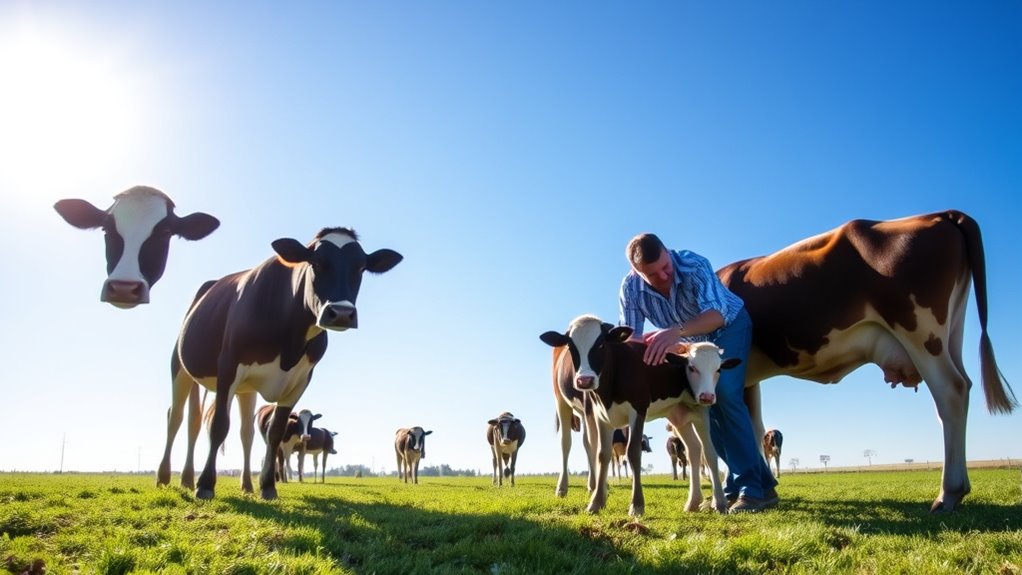
When managing a dairy herd, understanding the key principles is essential for guaranteeing productivity and animal welfare.
Start by focusing on cow nutrition; make certain your dairy cows consume more nutrients than they produce in milk. Follow feeding guidelines—1.2% of body weight for non-pregnant cows and 1.2% plus 5 kg per 10 liters of milk for lactating cows.
Focus on cow nutrition to ensure they receive more nutrients than they produce in milk, following specific feeding guidelines for optimal health.
Regularly monitor reproduction cycles and health issues to maximize herd size and productivity. Prioritize cow comfort with clean bedding and proper ventilation to boost milk production.
Implement calm milking practices and maintain hygiene by cleaning teats before and after milking.
Finally, incorporate veterinary care, emphasizing preventative measures like vaccinations to enhance health and safety, reducing disease risk and financial losses.
Nutrition and Feeding Strategies
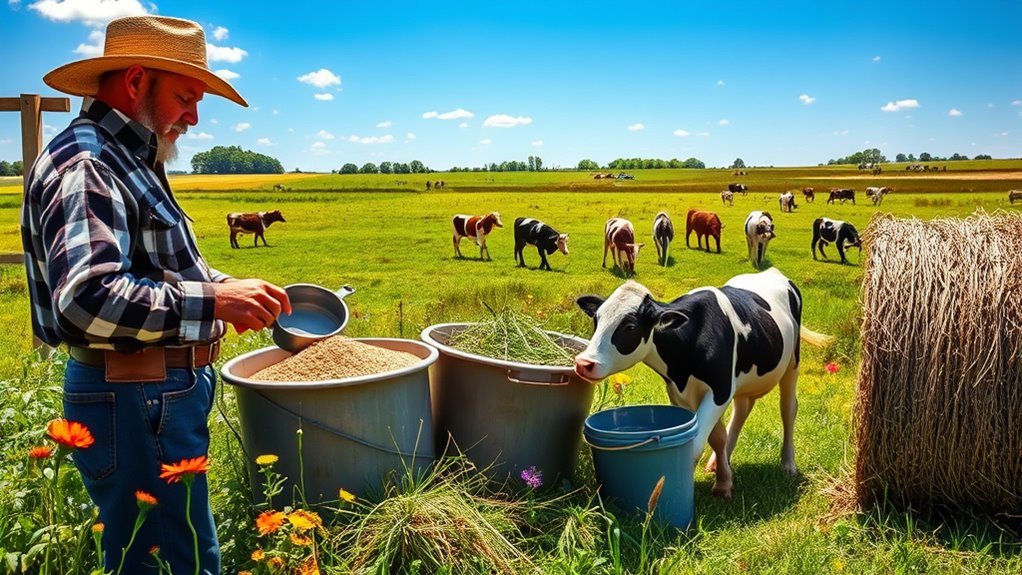
When managing your dairy herd, understanding nutrient intake requirements is essential for ideal health and milk production.
You'll need to focus on effective forage management techniques to guarantee your cows get the right balance of nutrients.
Nutrient Intake Requirements
Understanding nutrient intake requirements is vital for maintaining a healthy and productive dairy herd. You need to evaluate the specific needs of your dairy cows based on their stage of life.
- Non-pregnant adult cows require 1.2% of their body weight in nutrients.
- Pregnant, non-lactating cows need 2% for proper health and development.
- Milking cows demand 1.2% of their body weight plus an additional 5 kg for every 10 liters of milk produced.
Consistent energy from starch and fats, along with vitamins, is essential for ideal milk production.
Effective forage management and adjusting feed based on seasonal changes will maximize nutrient intake and enhance the overall health and productivity of your dairy herd.
Forage Management Techniques
Effective forage management is essential to ensuring your dairy herd thrives, particularly during critical periods like lactation.
To support peak milk production, you should allocate 1.5 to 2.0 acres per cow. This space helps maintain clean and dry forage while ensuring your cows have access to high-quality grass.
Supplementing forage with concentrates provides the necessary energy from starch and fats, especially for milking cows, who need additional nutrients based on their milk output.
Regularly monitor forage quality, as low-quality feed can negatively impact milk production.
During off-seasons, consider vitamin supplements to maintain overall cow health.
Breeding and Reproduction Practices
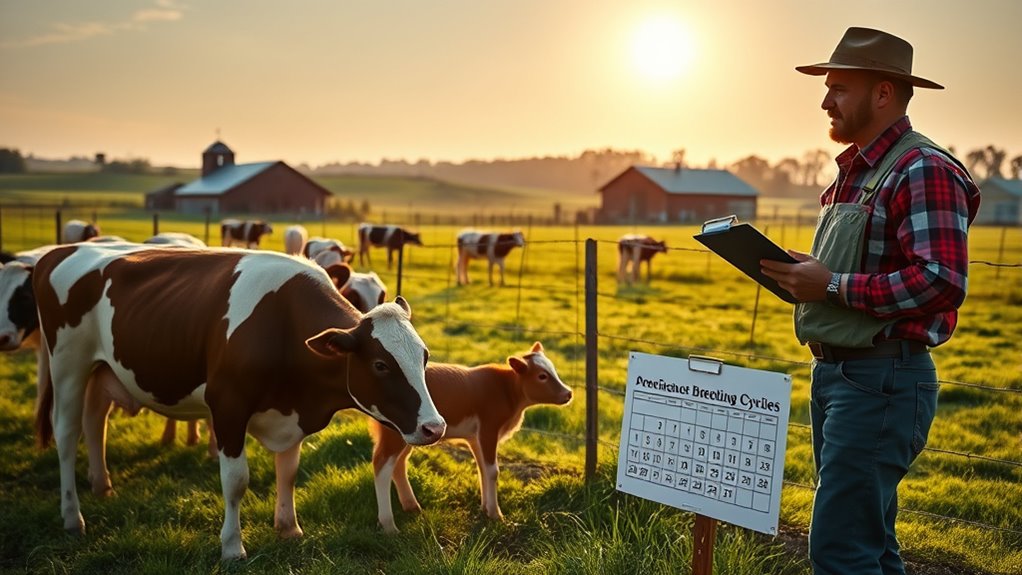
Managing breeding and reproduction practices in a dairy herd requires attention to detail and proactive strategies. To enhance your herd's reproductive health and efficiency, consider the following practices:
- Keep detailed records of breeding dates and heat cycles.
- Use activity monitors for better heat detection.
- Aim for heifers to achieve first calving under 24 months.
- Involve a veterinarian for artificial insemination and health checks.
A clean and comfortable environment is essential for cow welfare, as stress can negatively impact reproductive performance.
By prioritizing these practices, you'll increase your herd's conception rates and overall productivity, ensuring a healthier and more profitable dairy operation.
Milking Techniques and Quality Management
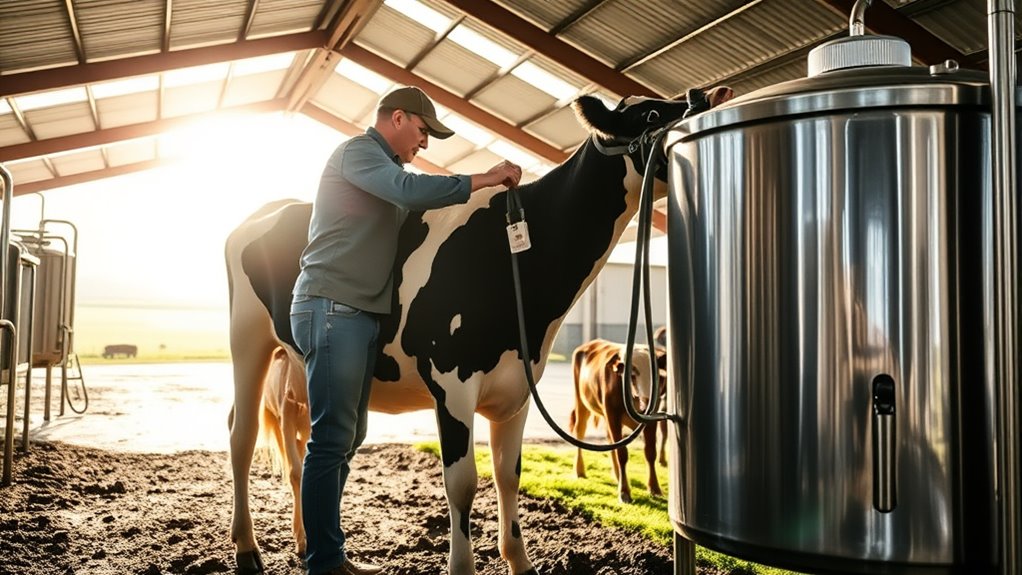
To guarantee high milk yield and quality, creating a calm and quiet environment during milking is essential. Stress negatively impacts milking cows, so make sure milking occurs consistently, typically twice a day. Maintain clean teats by washing and drying them before milking, and use antiseptic afterward to uphold milk quality. Regularly clean and sanitize your milking equipment to avoid contamination.
| Milking Practice | Importance | Frequency |
|---|---|---|
| Clean teats | Prevents disease | Before each milking |
| Sanitize equipment | Guarantees milk hygiene | Daily |
| Monitor milk quality | Detects issues early | Each milking session |
Cow Welfare and Comfortable Living Conditions
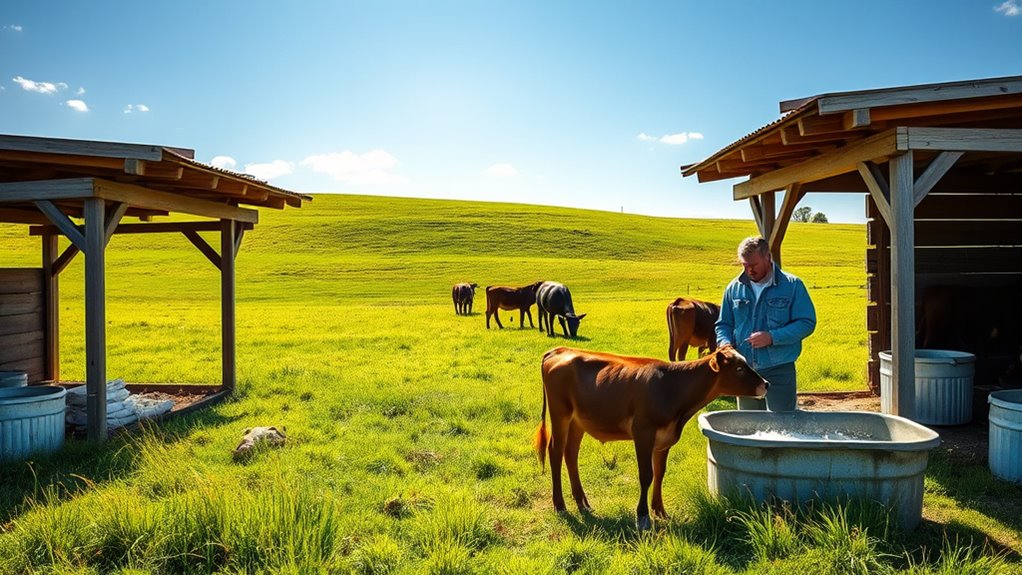
Creating a comfortable living environment for your dairy herd is essential for their overall health and milk production.
Prioritizing cow welfare means making sure that your cows thrive in conditions that promote their well-being. Here are key aspects to take into account:
- Provide clean, dry bedding and ample lying space to enhance comfort.
- Use non-slip flooring to prevent injuries and promote safety.
- Ensure proper ventilation to reduce heat stress, keeping temperatures ideally between 6 and 18°C (43 and 65°F).
- Guarantee access to fresh pasture and clean water daily for ideal herd health.
Veterinarian Care and Herd Health Economics
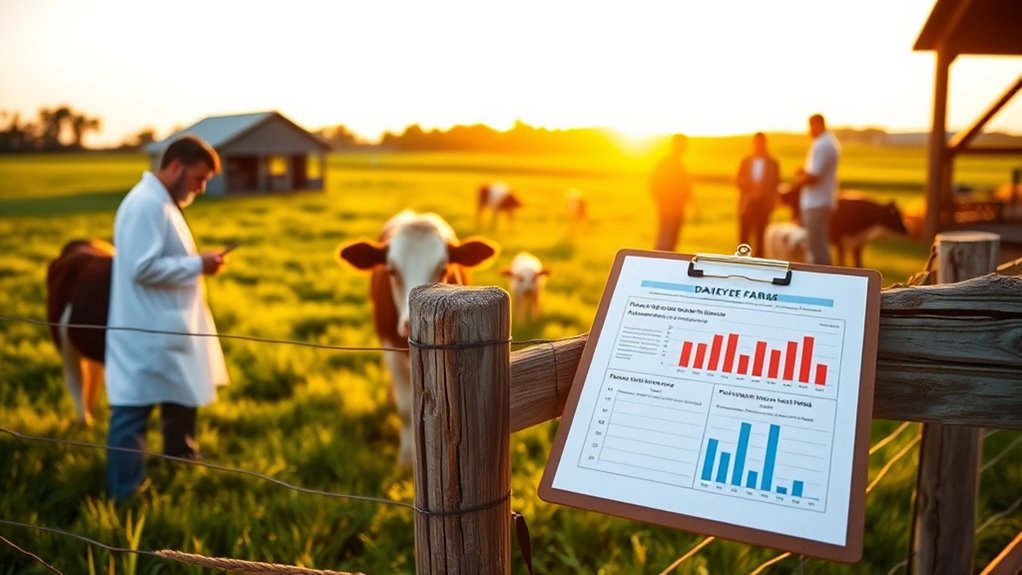
While guaranteeing your dairy herd thrives, regular veterinarian care plays an essential role in maintaining their health and your farm's financial stability.
As a dairy farmer, you know that preventative care, such as vaccinations and routine health checks, is fundamental for enhancing cow health and reducing disease incidence. This proactive approach not only safeguards your herd but also saves you money in the long run.
Budgeting for veterinarian bills is imperative; setting aside funds for medications and emergency care prevents unexpected financial strains.
Setting aside funds for veterinary care is essential to avoid financial surprises and ensure your herd's health.
Building a reliable relationship with your local veterinarian fosters trust and guarantees timely interventions, which are critical for peak herd health.
Heat Stress Management and Cooling Strategies
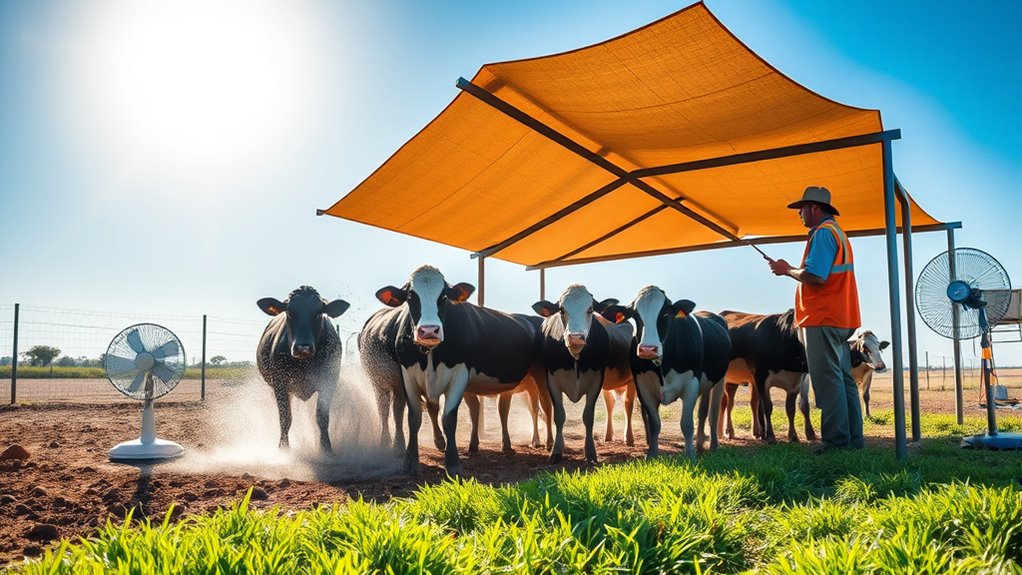
Maintaining your dairy herd's health goes beyond routine veterinary care; it also involves managing environmental factors like heat stress, which can greatly impact milk production.
When temperatures exceed 18°C (65°F), cows suffer, leading to decreased milk yield and health issues.
Implement effective cooling strategies to keep your herd comfortable and productive:
- Provide ample shade to protect cows from direct sunlight.
- Use ceiling fans to enhance air circulation.
- Employ sprinklers or misters to lower temperatures.
- Guarantee proper ventilation in barns to facilitate heat dissipation.
Keep an eye on humidity levels, as high humidity can worsen heat stress.
Frequently Asked Questions
How Many Acres Do You Need for a Small Dairy Farm?
For a small dairy farm, you'll typically need 2 to 5 acres of land per cow, depending on pasture quality and local conditions.
To optimize forage management, aim for about 1.5 to 2 acres per cow, which also includes space for any youngstock.
Remember, during winter months, you might need to supplement with hay to guarantee your cows get enough nutrition, regardless of pasture size.
Proper land management is key to success.
What Is the Single Most Important Factor in Managing a Profitable Dairy Herd?
When you think about managing a profitable dairy herd, the single most important factor is cow nutrition.
You need to guarantee that your cows consume more nutrients than they produce in milk. This means following feeding guidelines closely, especially for lactating cows, who require additional nutrients.
Proper nutrition directly impacts milk production and overall herd health, so always prioritize what your cows eat to maximize their efficiency and profitability.
How Many Cows Can You Have on a Small Dairy Farm?
On a small dairy farm, you can typically accommodate around four cows. This size allows you to provide quality care and attention to each animal.
To guarantee proper nutrition and grazing, allocate about 1.5 to 2.0 acres of land per cow. Keep in mind that your herd size should align with your land availability and resources, as having too many cows can strain your feed supply and impact your overall efficiency.
Can a Small Dairy Farm Be Profitable?
Yes, a small dairy farm can be profitable if you manage costs effectively and cultivate a loyal customer base.
By selling milk directly from your farm, you can earn between $6 to $10 per gallon.
Focus on optimizing herd management, nutrition, and breeding to boost milk production.
Also, consider sustainable practices like efficient waste management to cut costs.
With the right strategies, you can enhance your income and guarantee your farm's success.
Conclusion
Managing a small dairy herd might seem challenging, but with the right strategies, it can be rewarding and efficient. By focusing on nutrition, breeding, and cow welfare, you'll not only enhance milk quality but also boost your herd's overall health. Just imagine walking through your barn, hearing contented mooing, and knowing you've created a thriving environment. With a bit of dedication and the right practices, you can turn your dairy dream into a successful reality!

